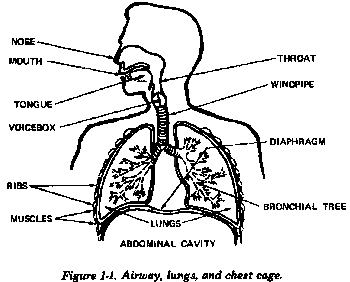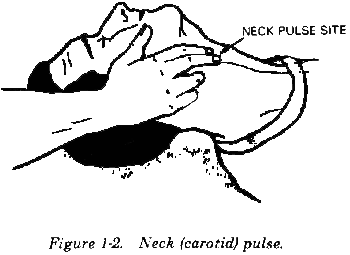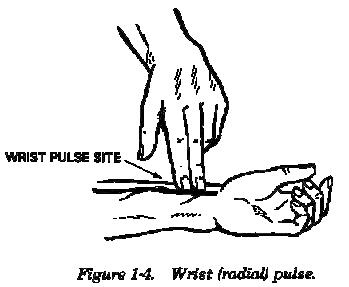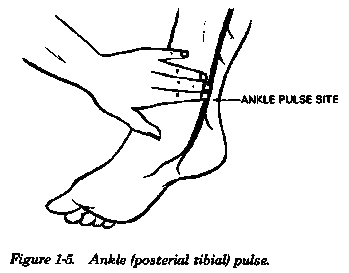First Aid for Soldiers FM 21-11
Fundamental Criteria for First Aid
Headquarters, Department of the Army, Washington, D.C., October 27, 1988
INTRODUCTION Soldiers may have to depend upon their first aid knowledge and
skills to save themselves or other soldiers. They may be able to save a life, prevent
permanent disability, and reduce long periods of hospitalization by knowing what
to do, what not to do, and when to seek medical assistance. Anything
soldiers can do to keep others in good fighting condition is part of the primary mission
to fight or to support the weapons system. Most injured or ill soldiers are able to return
to their units to fight and/or support primarily because they are given appropriate
and timely first aid followed by the best medical care possible. Therefore, all
soldiers must remember the basics:
Section I. EVALUATE CASUALTY
1-1. Casualty Evaluation
(081-831-1000)
|
The time may come when you must instantly apply your knowledge of lifesaving and first
aid measures, possibly under combat or other adverse conditions. Any soldier observing an
unconscious and/or ill, injured, or wounded person must carefully and skillfully evaluate
him to determine the first aid measures required to prevent further injury or death. He
should seek help from medical personnel as soon as possible, but must NOT interrupt his
evaluation or treatment of the casualty. A second person may be sent to find medical help.
One of the cardinal principles of treating a casualty is that the initial rescuer must
continue the evaluation and treatment, as the tactical situation permits, until he is
relieved by another individual. If, during any part of the evaluation, the casualty
exhibits the conditions for which the soldier is checking, the soldier must stop the
evaluation and immediately administer first aid. In a chemical environment, the soldier
should not evaluate the casualty until the casualty has been masked and given the
antidote. After providing first aid, the soldier must proceed with the evaluation and
continue to monitor the casualty for further medical complications until relieved by
medical personnel. Learn the following procedures well. You may become that soldier
who will have to give first aid some day.
NOTE
Remember, when evaluating and/or treating a casualty, you should seek
medical aid as soon as possible. DO NOT stop treatment, but if the
situation allows, send another person to find medical aid. |
WARNING
Again, remember, if there are any signs of chemical or biological agent
poisoning, you should immediately mask the casualty. If it is nerve agent
poisoning, administer the antidote, using the casualty's injector/ampules.
See task 081-831-1031,
Administer First Aid to a
Nerve Agent
Casualty (Buddy Aid). |
|
a. Step ONE. Check the casualty for responsiveness by gently shaking or
tapping him while calmly asking, "Are you okay?" Watch for response. If the
casualty does not respond, go to step TWO. See Chapter 2,
paragraph 2-5 for more information. If the casualty responds, continue with the
evaluation.
(1) If the casualty is conscious, ask him where he feels different than usual or where
it hurts. Ask him to identify the location(s) of pain if he can, or to identify the area
in which there is no feeling.
(2) If the casualty is conscious but is choking and cannot talk, stop the evaluation
and begin treatment. See task 081-831-1003, Clear an
Object from the Throat of a Conscious Casualty. Also see Chapter 2, paragraph 2-13 for specific details on opening
the airway.
WARNING
IF A BROKEN NECK OR BACK IS SUSPECTED, DO NOT MOVE THE CASUALTY UNLESS TO SAVE HIS
LIFE. MOVEMENT MAY CAUSE PERMANENT PARALYSIS OR DEATH.
b. Step TWO. Check for breathing. See Chapter 2,
paragraph 2-5c for procedure.
(1) If the casualty is breathing, proceed to step FOUR.
(2) If the casualty is not breathing, stop the evaluation and begin treatment (attempt
to ventilate). See task 081-831-1042, Perform
Mouth-to-Mouth Resuscitation. If an airway obstruction is apparent, clear the airway
obstruction, then ventilate.
c. Step THREE. Check for pulse. If pulse is present, and the casualty is
breathing, proceed to step FOUR.
|
* (2) If pulse is not found, seek medically
trained personnel for help.
|
d. Step FOUR. Check for bleeding. Look for spurts of blood or blood-soaked
clothes. Also check for both entry and exit wounds. If the casualty
is bleeding from an open wound, stop the evaluation and begin first aid treatment in
accordance with the following tasks, as appropriate:
(3) Open head wound--Task 081-831-1033, Apply a Dressing to an Open Head
Wound. See Chapter 3, Section I.
|
WARNING
IN A CHEMICALLY CONTAMINATED AREA, DO NOT EXPOSE THE WOUND(S).
|
|
e. Step FIVE. Check for shock. If signs/symptoms of shock are present, stop
the evaluation and begin treatment immediately. The following are nine signs and/or
symptoms of shock.
(1) Sweaty but cool skin (clammy skin).
(2) Paleness of skin.
(3) Restlessness or nervousness.
(4) Thirst.
(5) Loss of blood (bleeding).
(6) Confusion (does not seem aware of surroundings).
(7) Faster than normal breathing rate.
(8) Blotchy or bluish skin, especially around the mouth.
(9) Nausea and/or vomiting.
|
|
|
WARNING
|
See Chapter 2, Section III for specific information
regarding the causes and effects, signs/symptoms, and the treatment/prevention of shock.
|
f. Step SIX. Check for fractures (Chapter 4).
-
Pain or tenderness of the neck or back area.
-
Cuts or bruises in the neck or back area.
-
Inability of a casualty to move (paralysis or numbness).
o Ask about ability to move
(paralysis).
o Touch the casualty's arms and legs and ask whether he can feel your hand (numbness).
-
Unusual body or limb position.
|
WARNING
UNLESS THERE IS IMMEDIATE LIFE-THREATENING DANGER, DO NOT
MOVE A CASUALTY WHO HAS A SUSPECTED BACK OR NECK INJURY.
MOVEMENT MAY CAUSE PERMANENT PARALYSIS OR DEATH.
|
|
|
(5) Check for signs/symptoms of fractures of other body areas (for example, shoulder or
hip) and treat as necessary.
|
g. Step SEVEN. Check for burns. Look carefully for reddened, blistered, or
charred skin, also check for singed clothing. If burns are found, stop the evaluation and
begin treatment (Chapter 3, paragraph 3-14). See task 081-831-1007, Give First Aid for Burns.
|
|
h. Step EIGHT. Check for possible head injury.
|
(2) If a head injury is suspected, continue to watch for signs which would require
performance of mouth-to-mouth resuscitation, treatment for shock, or control of bleeding
and seek medical aid. See Chapter 3, Section I for
specific indications of head injury and treatment. See task
081-831-1033, Apply a Dressing to an Open Head Wound.
When a nonmedically trained soldier comes upon an unconscious and/or injured soldier,
he must accurately evaluate the casualty to determine the first aid measures needed to
prevent further injury or death. He should seek medical assistance as soon as possible,
but he MUST NOT interrupt treatment. To interrupt treatment may cause more harm
than good to the casualty. A second person may be sent to find medical help. If, during
any part of the evaluation, the casualty exhibits the conditions for which the soldier is
checking, the soldier must stop the evaluation and immediately administer first aid.
Remember that in a chemical environment, the soldier should not evaluate the casualty
until the casualty has been masked and given the antidote. After performing first aid, the
soldier must proceed with the evaluation and continue to monitor the casualty for
development of conditions which may require the performance of necessary basic life saving
measures, such as clearing the airway, mouth-to-mouth resuscitation preventing shock,
and/or bleeding control. He should continue to monitor until relieved by medical
personnel.
Section II. UNDERSTAND VITAL BODY FUNCTIONS
1-3. Respiration and Blood Circulation
Respiration (inhalation and exhalation) and blood circulation are vital body functions.
Interruption of either of these two functions need not be fatal IF appropriate first aid
measures are correctly applied.
a. Respiration. When a person inhales, oxygen is taken into the body and when
he exhales, carbon dioxide is expelled from the body--this is respiration. Respiration
involves the--
-
Airway (nose, mouth, throat, voice box, windpipe, and bronchial tree). The
canal through which air passes to and from the lungs.
-
Chest cage (formed by the muscle-connected ribs which join the spine in back
and the breastbone in front). The top part of the chest cage is closed by the structure of
the neck, and the bottom part is separated from the abdominal cavity by a large
dome-shaped muscle called the diaphragm (Figure 1-1). The diaphragm
and rib muscles, which are under the control of the respiratory center in the brain,
automatically contract and relax. Contraction increases and relaxation
decreases the size of the chest cage.
When the chest cage increases and then decreases, the air pressure in the lungs is
first less and then more than the atmospheric pressure, thus causing the air to rush in
and out of the lungs to equalize the pressure. This cycle of inhaling and exhaling is
repeated about 12 to 18 times per minute.

b. Blood Circulation. The heart and the blood vessels (arteries, veins, and
capillaries) circulate blood through the body tissues. The heart is divided into two
separate halves, each acting as a pump. The left side pumps oxygenated blood (bright red)
through the arteries into the capillaries; nutrients and oxygen pass from the blood
through the walls of the capillaries into the cells. At the same time waste products and
carbon dioxide enter the capillaries. From the capillaries the oxygen poor blood is
carried through the veins to the right side of the heart and then into the lungs where it
expels carbon dioxide and picks up oxygen. Blood in the veins is dark red because of its
low oxygen content. Blood does not flow through the veins in spurts as it does through the
arteries.
(1) Heartbeat. The heart functions as a pump to circulate the blood
continuously through the blood vessels to all parts of the body. It contracts,
forcing the blood from its chambers; then it relaxes, permitting its chambers to
refill with blood. The rhythmical cycle of contraction and relaxation is
called the heartbeat. The normal heartbeat is from 60 to 80 beats per minute.
(2) Pulse. The heartbeat causes a rhythmical expansion and contraction
of the arteries as it forces blood through them. This cycle of expansion and contraction
can be felt (monitored) at various body points and is called the pulse. The
common points for checking the pulse are at the side of the neck (carotid), the groin
(femoral), the wrist (radial), and the ankle (posterial tibial).




NOTE
DO NOT use your thumb to check a casualty's pulse because you may
confuse your pulse beat with that of the casualty. |
1-4. Adverse Conditions
a. Lack of Oxygen. Human life cannot exist without a continuous intake of
oxygen. Lack of oxygen rapidly leads to death. First aid involves knowing how to OPEN
THE AIRWAY AND RESTORE BREATHING AND HEARTBEAT (Chapter
2, Section I).
b. Bleeding. Human life cannot continue without an adequate volume of blood to
carry oxygen to the tissues. An important first aid measure is to STOP THE
BLEEDING to prevent loss of blood (Chapter 2,
Section II).
c. Shock. Shock means there is inadequate blood flow to the vital tissues and
organs. Shock that remains uncorrected may result in death even though the injury or
condition causing the shock would not otherwise be fatal. Shock can result from many
causes, such as loss of blood, loss of fluid from deep burns, pain, and reaction to the
sight of a wound or blood. First aid includes PREVENTING SHOCK, since the
casualty's chances of survival are much greater if he does not develop shock (Chapter 2, Section III).
d. Infection. Recovery from a severe injury or a wound depends largely upon
how well the injury or wound was initially protected. Infections result from the
multiplication and growth (spread) of germs (bacteria: harmful microscopic organisms).
Since harmful bacteria are in the air and on the skin and clothing, some of these
organisms will immediately invade (contaminate) a break in the skin or an open wound. The
objective is to KEEP ADDITIONAL GERMS OUT OF THE WOUND. A good working
knowledge of basic first aid measures also includes knowing how to dress the wound to
avoid infection or additional contamination (Chapters 2 and 3).
|







